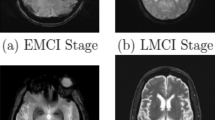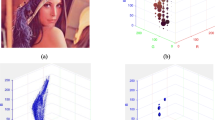Abstract
The image segmentation method is crucial for disease diagnosis as it provides radiologists with important patient information in a non-invasive form. The adopted image segmentation method significantly impacts diagnostic efficiency and accuracy. Multi-level thresholding is extensively utilized in medical image segmentation owing to its effectiveness and computational simplicity. Conventional techniques, such as Otsu’s method for maximizing between-class variance, have shown effectiveness in determining optimal thresholds. However, their application in scenarios requiring more than two thresholds can lead to high computational demands. Although meta-heuristic algorithms are often used for threshold determination, they frequently encounter challenges such as inaccurate convergence, a propensity to settle in local optima, and increased sensitivity as the number of thresholds rises. To tackle these challenges, we introduce a novel algorithm called the enhanced Walrus optimizer (EWO). EWO is crafted for tasks involving image segmentation and global optimization, with the objective of enhancing both accuracy and efficiency in selecting thresholds for medical image segmentation. The algorithm employs opposition-based learning alongside a tridistribution optimal mutation strategy that harnesses three different distribution functions (Lévy, Gaussian, and Cauchy) to mutate search agents. This methodology boosts the quality of solutions and improves the diversity of search agents. We further conduct experimental comparisons of the proposed EWO algorithm against six benchmark algorithms on MRI brain images, employing evaluation methods including objective function values, peak signal-to-noise ratio (PSNR), structural similarity index (SSIM), and feature similarity index (FSIM). EWO achieved superior performance, obtaining the best mean objective function values in 78.57% (22 out of 28) of the cases and the lowest standard deviation of objective function values in 60.71% (17 out of 28) of the cases. For PSNR, EWO was optimal in 39.28% (11 out of 28) of the mean cases and in 71.43% (20 out of 28) for standard deviation. The SSIM results showed that EWO performed best in 71.43% (20 out of 28) of the mean cases and in 82.13% (23 out of 28) for standard deviation. In FSIM, EWO achieved optimal performance in 82.13% (23 out of 28) of the mean cases and 67.86% (19 out of 28) for standard deviation. These results highlight EWO’s superior performance, accuracy, and stability in obtaining optimal thresholds, especially in the context of high-level thresholding.








Similar content being viewed by others
Data availability
Data will be made available on request.
References
Abdel-Basset M, Mohamed R, Azeem SAA et al (2023) Kepler optimization algorithm: a new metaheuristic algorithm inspired by Kepler’s laws of planetary motion. Knowl-Based Syst. https://doi.org/10.1016/j.knosys.2023.110454
Abdel-Basset M, Mohamed R, Jameel M et al (2023) Nutcracker optimizer: a novel nature-inspired metaheuristic algorithm for global optimization and engineering design problems. Knowl-Based Syst 262:110248. https://doi.org/10.1016/j.knosys.2022.110248
Abdollahzadeh B, Khodadadi N, Barshandeh S et al (2024) Puma optimizer (po): a novel metaheuristic optimization algorithm and its application in machine learning. Clust Comput. https://doi.org/10.1007/s10586-023-04221-5
Ali M, Pant M (2011) Improving the performance of differential evolution algorithm using Cauchy mutation. Soft Comput 15:991–1007
Brar KK, Goyal B, Dogra A et al (2025) Image segmentation review: theoretical background and recent advances. Inf Fusion 114:102608. https://doi.org/10.1016/j.inffus.2024.102608
García S, Molina D, Lozano M et al (2009) A study on the use of non-parametric tests for analyzing the evolutionary algorithms’ behaviour: a case study on the cec’2005 special session on real parameter optimization. J Heurist 15:617–644
García-Gutiérrez V, González A, Cuevas E et al (2024) Detection of COVID-19: a metaheuristic-optimized maximally stable extremal regions approach. Symmetry 16(7):870
Ghasemi M, Zare M, Trojovský P et al (2024) Optimization based on the smart behavior of plants with its engineering applications: ivy algorithm. Knowl-Based Syst 295:111850. https://doi.org/10.1016/j.knosys.2024.111850
Gill HS, Khehra BS (2022) Apple image segmentation using teacher learner based optimization based minimum cross entropy thresholding. Multimed Tools Appl 81(8):11005–11026
Guo H, Li M, Liu H et al (2024) Multi-threshold image segmentation based on an improved salp swarm algorithm: case study of breast cancer pathology images. Comput Biol Med 168:107769. https://doi.org/10.1016/j.compbiomed.2023.107769
Han M, Du Z, Yuen KF et al (2024) Walrus optimizer: a novel nature-inspired metaheuristic algorithm. Expert Syst Appl 239:122413
Hao S, Huang C, Heidari AA et al (2023) Multi-threshold image segmentation using an enhanced fruit fly optimization for COVID-19 x-ray images. Biomed Signal Process Control 86:105147. https://doi.org/10.1016/j.bspc.2023.105147
Houssein EH, Abdelkareem DA, Emam MM et al (2022) An efficient image segmentation method for skin cancer imaging using improved golden jackal optimization algorithm. Comput Biol Med 149:106075
Houssein EH, Mohamed GM, Ibrahim IA et al (2023) An efficient multilevel image thresholding method based on improved heap-based optimizer. Sci Rep 13(1):9094
Huang H, Meng F, Zhou S et al (2019) Brain image segmentation based on FCM clustering algorithm and rough set. IEEE Access 7:12386–12396
Kamaruzaman AF, Zain AM, Yusuf SM et al (2013) Levy flight algorithm for optimization problems-a literature review. Appl Mech Mater 421:496–501
Kwon GR, Basukala D, Lee SW et al (2016) Brain image segmentation using a combination of expectation-maximization algorithm and watershed transform. Int J Imaging Syst Technol 26(3):225–232
Mahmud BU, Hong GY, Mamun AA et al (2023) Deep learning-based segmentation of 3d volumetric image and microstructural analysis. Sensors 23(5):2640
Matoušová I, Trojovskỳ P, Dehghani M et al (2023) Mother optimization algorithm: a new human-based metaheuristic approach for solving engineering optimization. Sci Rep 13(1):10312
Meenachi L, Ramakrishnan S (2021) Metaheuristic search based feature selection methods for classification of cancer. Pattern Recognit 119:108079. https://doi.org/10.1016/j.patcog.2021.108079
Mostafa RR, Khedr AM, Aziz A (2022) Istoa: an improved sooty tern optimization algorithm for multilevel threshold image segmentation. In: International Conference on Next Generation Wired/Wireless Networking, Springer, pp 133–148
Mostafa RR, Houssein EH, Hussien AG et al (2024) An enhanced chameleon swarm algorithm for global optimization and multi-level thresholding medical image segmentation. Neural Comput Appl 36(15):8775–8823. https://doi.org/10.1007/s00521-024-09524-1
Otsu N (1979) A threshold selection method from gray-level histograms. IEEE Trans Syst Man Cybern 9(1):62–66. https://doi.org/10.1109/TSMC.1979.4310076
Saeed Z, Bouhali O, Ji JX et al (2024) Cancerous and non-cancerous MRI classification using dual DCNN approach. Bioengineering 11(5):410
Saeed Z, Torfeh T, Aouadi S et al (2024) An efficient ensemble approach for brain tumors classification using magnetic resonance imaging. Information 15(10):641
Sara U, Akter M, Uddin MS (2019) Image quality assessment through FSIM, SSIM, MSE and PSNR–a comparative study. J Comput Commun 7(3):8–18
Song S, Wang P, Heidari AA et al (2021) Dimension decided harris hawks optimization with gaussian mutation: balance analysis and diversity patterns. Knowl-Based Syst 215:106425
Sun H, Liu L, Li F (2024) A lie group semi-supervised FCM clustering method for image segmentation. Pattern Recognit 155:110681. https://doi.org/10.1016/j.patcog.2024.110681
Tarkhaneh O, Shen H (2019) An adaptive differential evolution algorithm to optimal multi-level thresholding for MRI brain image segmentation. Expert Syst Appl 138:112820. https://doi.org/10.1016/j.eswa.2019.07.037
Thom de Souza RC, de Macedo CA, dos Santos Coelho L et al (2020) Binary coyote optimization algorithm for feature selection. Pattern Recognit 107:107470. https://doi.org/10.1016/j.patcog.2020.107470
Wang Z, Yu F, Wang D et al (2024) Multi-threshold segmentation of breast cancer images based on improved dandelion optimization algorithm. J Supercomput 80(3):3849–3874
Yu X, Xu W, Li C (2021) Opposition-based learning grey wolf optimizer for global optimization. Knowl-Based Syst 226:107139
Zarate O, Zaldívar D, Cuevas E et al (2023) Enhancing pneumonia segmentation in lung radiographs: a jellyfish search optimizer approach. Mathematics 11(20):4363
Zhang J, Zhang T, Wang D et al (2024) A complex-valued encoding golden jackal optimization for multilevel thresholding image segmentation. Appl Soft Comput 165:112108
Zhou Y, Yang X, Ling Y et al (2018) Meta-heuristic moth swarm algorithm for multilevel thresholding image segmentation. Multimed Tools Appl 77(18):23699–23727. https://doi.org/10.1007/s11042-018-5637-x
Acknowledgements
This work is supported by the specific research fund of The Innovation Platform for Academicians of Hainan Province under Grant No. YSPTZX202410, the Guangdong Basic and Applied Basic Research Foundation under Grant No. 2021B1515120048, the South China Normal University teacher research and cultivation fund under Grant No. KJF120240001, the South China Normal University School of Software Development Fund under Grant No. 210123.
Author information
Authors and Affiliations
Contributions
JL was contributed formal analysis, funding acquisition, project administration, resources, supervision, and writing—review and editing. RL was involved in conceptualization, data curation, methodology, software, validation, and writing—original draft. BZ was performed ionvestigation and writing—review and editing. YD was done formal analysis and writing—review and editing. JZ did writing—review and editing. HF was carried out software and investigation.
Corresponding author
Ethics declarations
Conflict of interest
The authors declare no conflict of interest.
Additional information
Publisher's Note
Springer Nature remains neutral with regard to jurisdictional claims in published maps and institutional affiliations.
Rights and permissions
Springer Nature or its licensor (e.g. a society or other partner) holds exclusive rights to this article under a publishing agreement with the author(s) or other rightsholder(s); author self-archiving of the accepted manuscript version of this article is solely governed by the terms of such publishing agreement and applicable law.
About this article
Cite this article
Li, J., Lu, R., Zeng, B. et al. Multi-threshold medical image segmentation based on the enhanced walrus optimizer. J Supercomput 81, 513 (2025). https://doi.org/10.1007/s11227-025-07023-1
Accepted:
Published:
DOI: https://doi.org/10.1007/s11227-025-07023-1




